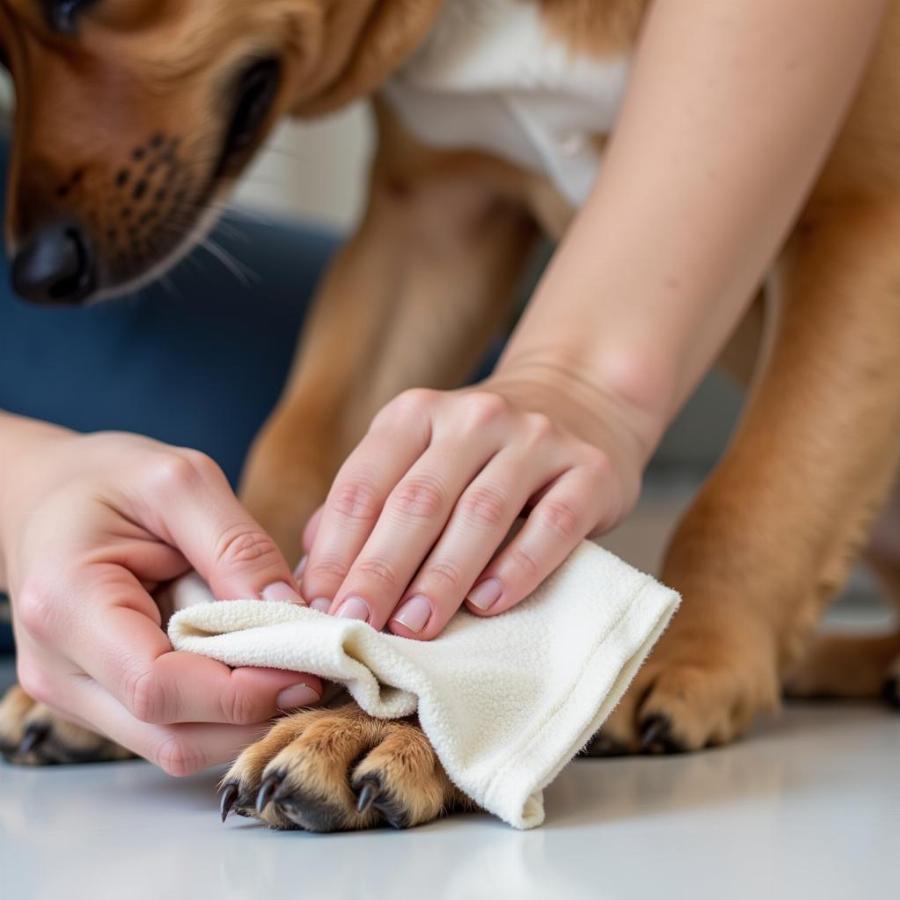Hyperkeratosis in dogs might sound intimidating, but understanding this common skin condition can help you provide the best care for your furry friend. While it can affect any breed, knowing the causes, symptoms, and treatment options can make all the difference in your dog’s comfort and overall well-being.
Understanding Canine Hyperkeratosis
Hyperkeratosis occurs when your dog’s body produces too much keratin, a tough protein found in their skin, paw pads, and nose. This excess keratin creates a rough, thickened, often crusty appearance, sometimes even resembling dried-out calluses in humans.
What causes hyperkeratosis in dogs? There are several reasons your canine companion might develop this condition:
- Genetics: Some breeds, like Bulldogs, Terriers, and Golden Retrievers, are genetically predisposed to certain types of hyperkeratosis.
- Age: Older dogs are more susceptible due to slower cell turnover.
- Underlying medical conditions: Hypothyroidism, zinc deficiency, and autoimmune diseases can also trigger hyperkeratosis.
- External factors: Exposure to rough surfaces, irritants, or extreme weather can exacerbate the condition.
Recognizing the Signs of Hyperkeratosis
Hyperkeratosis can manifest in various ways, and familiarizing yourself with the signs is crucial for early detection:
- Dry, cracked paw pads: This is the most common symptom, often causing discomfort while walking.
- Hardened, crusty nose: The nose might appear discolored or cracked.
- Thickened, scaly skin: You might notice these changes on your dog’s elbows, ears, or other areas.
Diagnosis and Treatment Options
If you suspect your dog might have hyperkeratosis, consult your veterinarian for a proper diagnosis. They’ll likely examine the affected areas and may recommend further tests to rule out underlying medical conditions.
Treatment for hyperkeratosis is generally aimed at managing the symptoms and improving your dog’s comfort. Your veterinarian might recommend:
- Topical creams and ointments: These often contain moisturizing agents like urea or salicylic acid to soften and exfoliate the hardened skin.
- Oral supplements: Biotin, Vitamin A, and Omega-3 fatty acid supplements can promote healthier skin and nail growth.
- Medicated shampoos and conditioners: These can help soften and remove excess keratin buildup.
“It’s important to address hyperkeratosis proactively,” says Dr. Emily Carter, a certified veterinary dermatologist. “Early intervention can prevent discomfort and secondary infections.”
Home Care for Dogs with Hyperkeratosis
 Dog Getting Paw Care
Dog Getting Paw Care
In addition to veterinary treatment, you can play a vital role in managing your dog’s hyperkeratosis at home:
- Regular paw checks and cleaning: Gently wipe your dog’s paws after walks to remove dirt and debris.
- Moisturize regularly: Apply a veterinarian-recommended paw balm or moisturizer to keep the pads hydrated.
- Provide a comfortable resting area: Soft bedding can reduce pressure on affected areas.
- Consider protective booties: These can shield your dog’s paws from rough surfaces and harsh weather conditions.
Living Well with Hyperkeratosis
While there’s no one-size-fits-all cure for hyperkeratosis, proper management can help your furry friend live a happy and comfortable life. By understanding the condition, recognizing the signs, and following your veterinarian’s recommendations, you can ensure your dog’s well-being.
Frequently Asked Questions about Hyperkeratosis in Dogs
1. Is hyperkeratosis in dogs contagious?
No, hyperkeratosis is not contagious to humans or other animals. It’s a non-infectious skin condition.
2. Can hyperkeratosis in dogs go away on its own?
While some cases might improve with time, hyperkeratosis often requires ongoing management to control symptoms and prevent complications.
3. How can I prevent my dog from getting hyperkeratosis?
While you can’t completely prevent all forms of hyperkeratosis, especially genetic predispositions, maintaining good paw hygiene, providing a balanced diet, and regular veterinary checkups can minimize the risk.
4. What should I do if my dog’s hyperkeratosis worsens?
If you notice any signs of infection, bleeding, or increased discomfort, contact your veterinarian immediately.
5. Are there any special dietary considerations for dogs with hyperkeratosis?
Talk to your veterinarian about incorporating foods rich in Omega-3 fatty acids, Vitamin E, and biotin into your dog’s diet to support skin health.
Seeking Further Information
For more insights into dog health and breed-specific information, explore other informative articles on our website.
Need personalized advice for your canine companion? Contact Beaut Dogs at [email protected] for expert guidance and support. We’re here to help you navigate the world of dog ownership with confidence and care.
Beaut Dogs is your trusted source for all things dog-related. We provide reliable information, helpful tips, and expert advice to empower dog owners worldwide. Visit us at https://beautdogs.com to learn more!